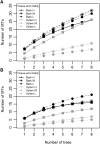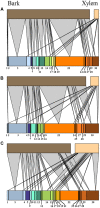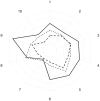Pedunculate Oaks (Quercus robur L.) Differing in Vitality as Reservoirs for Fungal Biodiversity
- PMID: 30123200
- PMCID: PMC6085435
- DOI: 10.3389/fmicb.2018.01758
Pedunculate Oaks (Quercus robur L.) Differing in Vitality as Reservoirs for Fungal Biodiversity
Abstract
Ecological significance of trees growing in urban and peri-urban settings is likely to increase in future land-use regimes, calling for better understanding of their role as potential reservoirs or stepping stones for associated biodiversity. We studied the diversity of fungal endophytes in woody tissues of asymptomatic even aged pedunculate oak trees, growing as amenity trees in a peri-urban setting. The trees were classified into three groups according to their phenotypic vitality (high, medium, and low). Endophytes were cultured on potato dextrose media from surface sterilized twigs and DNA sequencing was performed to reveal the taxonomic identity of the morphotypes. In xylem tissues, the frequency and diversity of endophytes was highest in oak trees showing reduced vitality. This difference was not found for bark samples, in which the endophyte infections were more frequent and communities more diverse than in xylem. In general, most taxa were shared across the samples with few morphotypes being recovered in unique samples. Leaf phenolic profiles were found to accurately classify the trees according to their phenotypic vitality. Our results confirm that xylem is more selective substrate for endophytes than bark and that endophyte assemblages in xylem are correlated to the degree of host vitality. Thus, high vitality of trees may be associated with reduced habitat quality to wood-associated endophytes.
Keywords: Quercus robur; endophytes; fungal diversity; network analysis; phenolics; tree vitality.
Figures








References
-
- Albrectsen B. R., Witzell J. (2012). “Disentangling functions of fungal endophytes in forest trees,” in Fungi: Types, Environmental Impact and Role in Disease eds Paz Silva A., Sol M. (Huntington, NY: Nova Science Publishers; ) 235–246.
-
- Bader P., Jansson S., Jonsson B. G. (1995). Wood-inhabiting fungi and substratum decline in selectively logged boreal spruce forests. Biol. Conserv. 72 355–362. 10.1016/0006-3207(94)00029-P - DOI
LinkOut - more resources
Full Text Sources
Other Literature Sources

